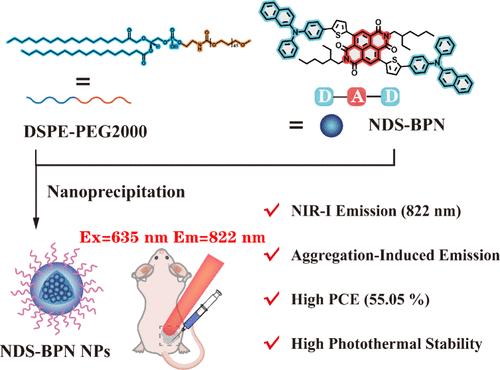Aggregation-Induced Emission-Active Organic Nanoagent with High Photothermal Conversion Efficiency for Near-Infrared Imaging-Guided Tumor Photothermal Therapy
IF 5.4
2区 医学
Q2 MATERIALS SCIENCE, BIOMATERIALS
引用次数: 0
Abstract
Photothermal therapy (PTT) provides a great prospect for noninvasive cancer therapy. However, it is still highly challenging to construct photothermal agents (PTAs) with the desired performances for imaging-guided PTT applications. Herein, a D–A–D-type naphthalene diamine (NDI)-based photothermal nano-PTAs NDS-BPN NP with near-infrared region (NIR) emission at 822 nm, aggregation-induced emission (AIE), high photothermal conversion efficiency (55.05%), and excellent photothermal stability is successfully designed and prepared through a simple two-step engineering method by using a new AIE molecule NDS-BPN and DSPE-PEG2000 as precursors. The prepared PTT nanoagents NDS-BPN NPs have been further applied for efficient photothermal ablation of cancer cells in vitro and also achieved the NIR fluorescent image-guided PTT tumor therapy in vivo with satisfactory results. We believe that this work provides an attractive NIR AIE NDI-based nano-PTA for the phototherapy of tumors as well as develops the construction strategy of NDI molecular-based photothermal nanoagents with desired performances for imaging-guided PTT.

具有高光热转换效率的聚合诱导发射活性有机纳米试剂用于近红外成像引导的肿瘤光热疗法
光热疗法(PTT)为无创癌症治疗提供了广阔的前景。然而,为成像引导的光热疗法应用构建具有理想性能的光热制剂(PTAs)仍然极具挑战性。本文以新型 AIE 分子 NDS-BPN 和 DSPE-PEG2000 为前体,通过简单的两步工程方法,成功设计并制备了一种基于 D-A-D 型萘二胺(NDI)的光热纳米 PTAs NDS-BPN NP,它具有 822 纳米的近红外发射、聚集诱导发射(AIE)、高光热转换效率(55.05%)和优异的光热稳定性。制备的 PTT 纳米试剂 NDS-BPN NPs 进一步应用于体外高效光热消融癌细胞,并在体内实现了近红外荧光图像引导的 PTT 肿瘤治疗,取得了令人满意的效果。我们相信,这项工作为肿瘤光疗提供了一种极具吸引力的基于近红外 AIE NDI 的纳米 PTA,同时也发展了具有理想性能的基于 NDI 分子的光热纳米试剂的构建策略,以用于成像引导的 PTT。
本文章由计算机程序翻译,如有差异,请以英文原文为准。
求助全文
约1分钟内获得全文
求助全文
来源期刊

ACS Biomaterials Science & Engineering
Materials Science-Biomaterials
CiteScore
10.30
自引率
3.40%
发文量
413
期刊介绍:
ACS Biomaterials Science & Engineering is the leading journal in the field of biomaterials, serving as an international forum for publishing cutting-edge research and innovative ideas on a broad range of topics:
Applications and Health – implantable tissues and devices, prosthesis, health risks, toxicology
Bio-interactions and Bio-compatibility – material-biology interactions, chemical/morphological/structural communication, mechanobiology, signaling and biological responses, immuno-engineering, calcification, coatings, corrosion and degradation of biomaterials and devices, biophysical regulation of cell functions
Characterization, Synthesis, and Modification – new biomaterials, bioinspired and biomimetic approaches to biomaterials, exploiting structural hierarchy and architectural control, combinatorial strategies for biomaterials discovery, genetic biomaterials design, synthetic biology, new composite systems, bionics, polymer synthesis
Controlled Release and Delivery Systems – biomaterial-based drug and gene delivery, bio-responsive delivery of regulatory molecules, pharmaceutical engineering
Healthcare Advances – clinical translation, regulatory issues, patient safety, emerging trends
Imaging and Diagnostics – imaging agents and probes, theranostics, biosensors, monitoring
Manufacturing and Technology – 3D printing, inks, organ-on-a-chip, bioreactor/perfusion systems, microdevices, BioMEMS, optics and electronics interfaces with biomaterials, systems integration
Modeling and Informatics Tools – scaling methods to guide biomaterial design, predictive algorithms for structure-function, biomechanics, integrating bioinformatics with biomaterials discovery, metabolomics in the context of biomaterials
Tissue Engineering and Regenerative Medicine – basic and applied studies, cell therapies, scaffolds, vascularization, bioartificial organs, transplantation and functionality, cellular agriculture
 求助内容:
求助内容: 应助结果提醒方式:
应助结果提醒方式:


